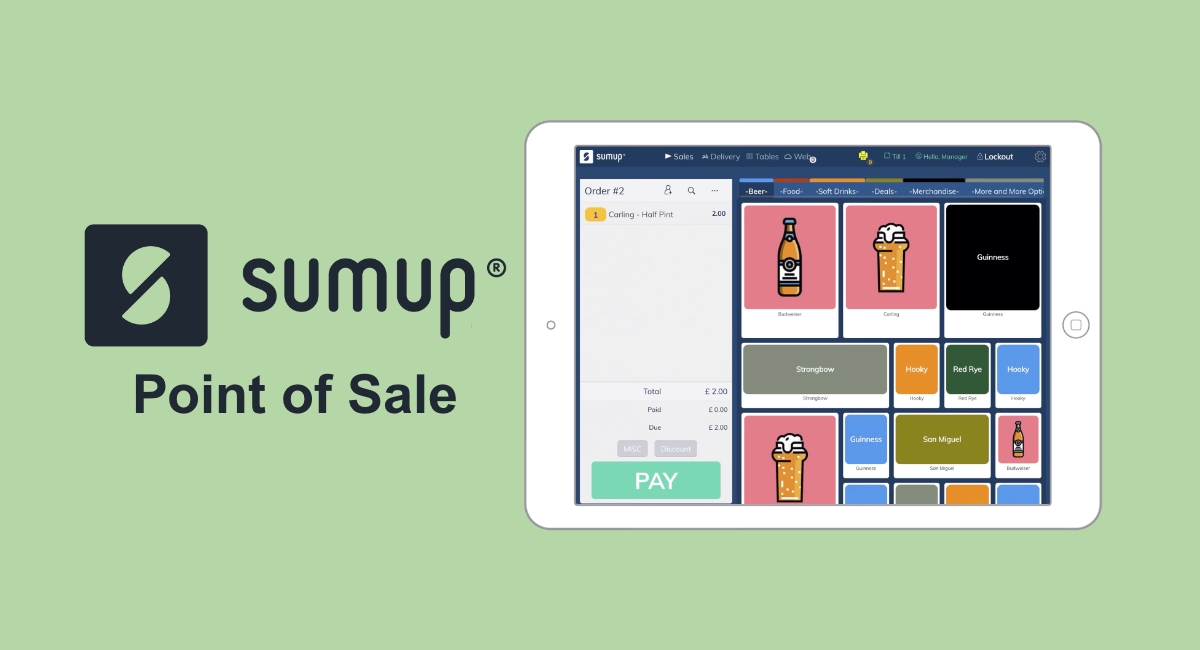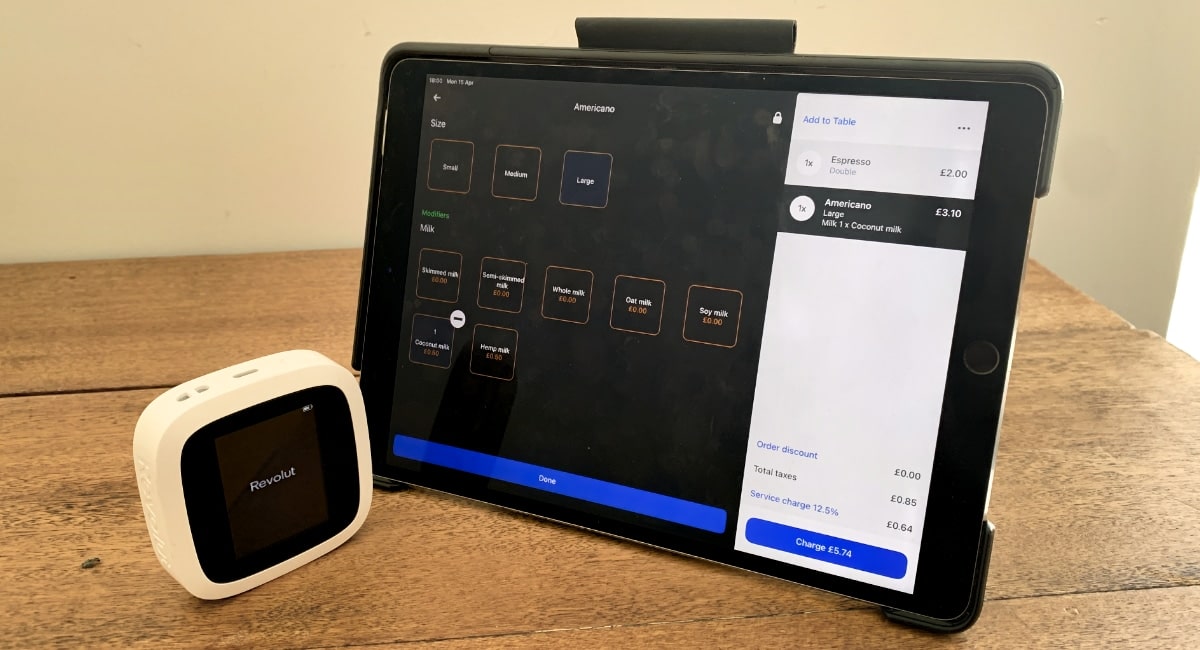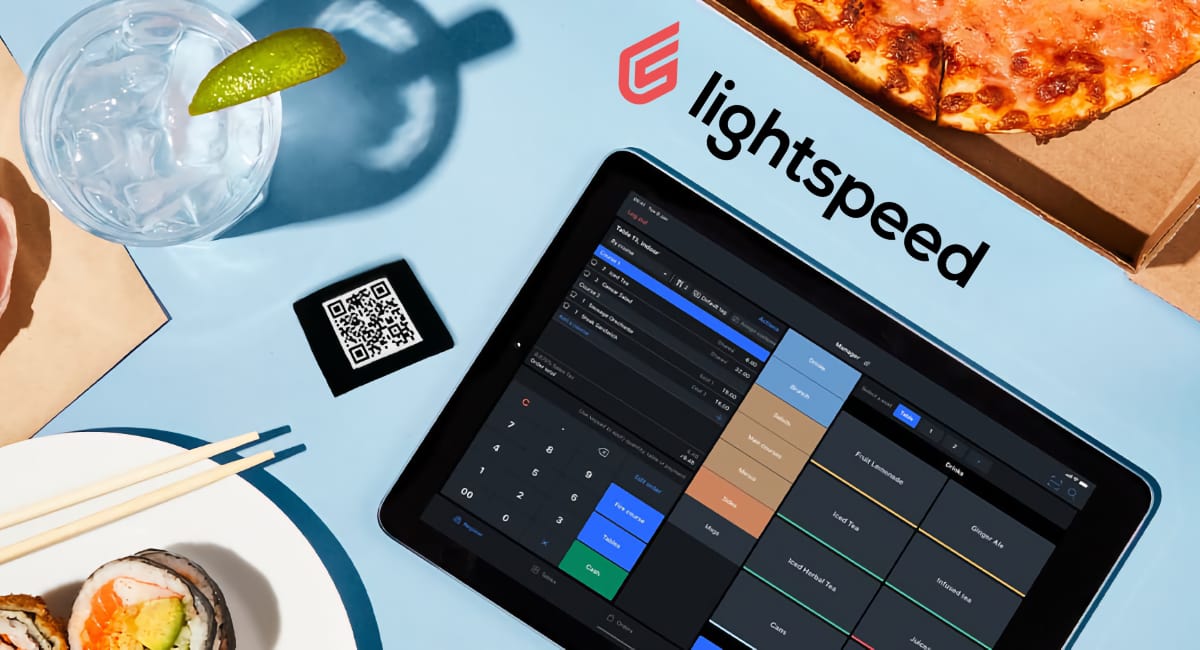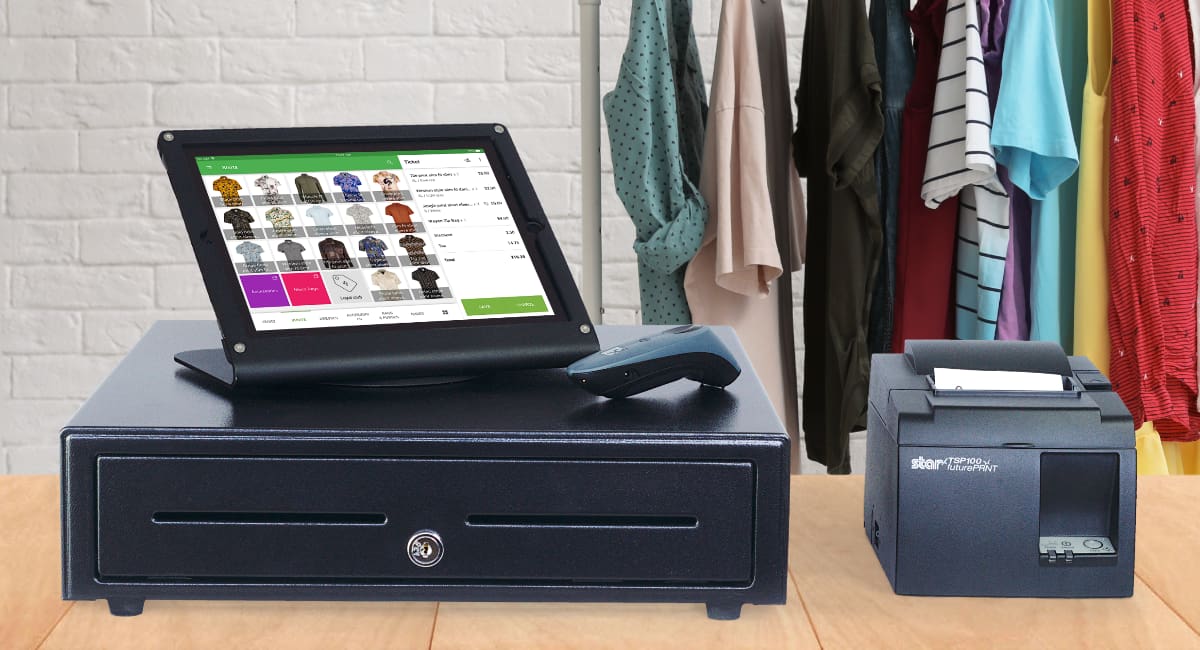- Pros: Affordable. Online ordering features. Offline mode. Choice of add-ons. Not too complicated. Low card rate. Next-day payouts.
- Cons: 12-month contract. No Android app. Have to request a demo from sales rep. So-so support. Fonts sometimes hard to read.
- Best for: SumUp users who want the cheapest, most convenient POS system with a low fixed transaction rate.
Contents
In brief
What is it?
Our opinion
In detail
Pricing
Setting up
POS features
Payments and hardware
Online ordering
Integrations
Service and reviews
MobileTransaction’s editor has personally tested and researched SumUp Point of Sale for an accurate experience. Screenshots and opinions are our own.
What is SumUp Point of Sale?
SumUp Point of Sale (POS) is the new name for the iPad POS system that used to be Goodtill. In 2020, SumUp acquired Goodtill and is still in the process of rebranding it completely. The POS system is built for hospitality, retail and services.
It works like this: you must subscribe to the main SumUp POS Pro plan containing features for any type of business, the SumUp Business Account and a low card processing rate if using a SumUp card machine. A few add-on ‘modules’ for specialised features, and integrations with other software, are available too, but online ordering features are included free.
Image: MobileTransaction
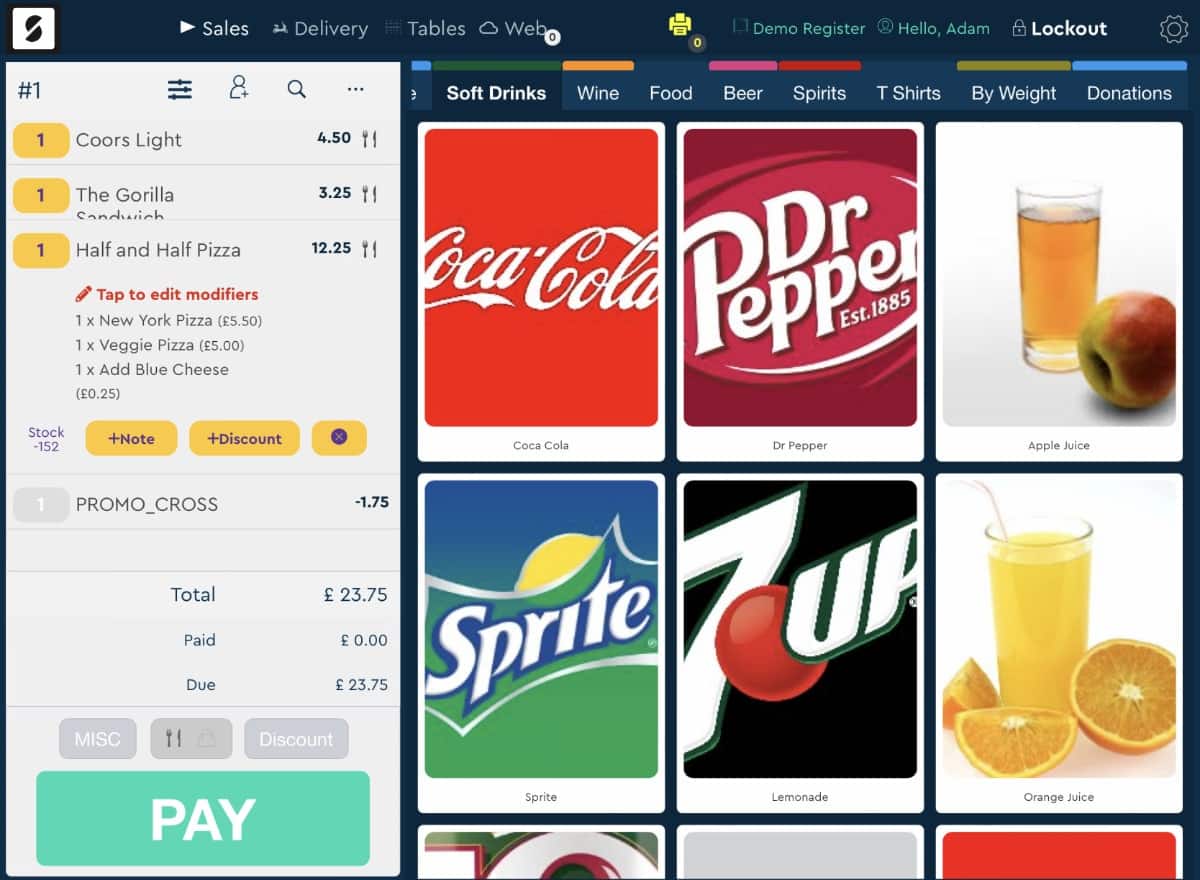
Example of a till layout in the SumUp POS app on iPad.
Merchants are offered a POS hardware bundle for a good price and can download the EPOS on iPad and access the backend admin account (‘Dashboard’) in any internet browser.
The POS software does not only work with SumUp card readers, it also works with Zettle and Dojo card terminals.
Our opinion: getting better, still not perfect
SumUp Point of Sale is a great place to start when SumUp’s app – or other free POS apps elsewhere – is no longer enough for your business. We like the colour-coded, highly customisable EPOS buttons and many optional features allowing you to tailor the checkout, customer ordering and more.
With the hardware bundles on offer, you can get an iPad register pretty cheaply with a professional interface adapted to your retail, hospitality or service business.
“A year’s POS commitment is a prohibitor for some, but SumUp’s cost is pretty competitive when you consider the 1.25% (or less) card rate for all cards. Not even Dojo can give you this rate, particularly with their monthly minimum charge.”
– Emily Sorensen, Senior Editor, MobileTransaction
The till app is efficient when you’re used to it, but it’s not entirely intuitive to set up from the backend. Certain features you’d expect to be there are not, and a lack of comprehensive resources online about all the settings can be frustrating in the beginning.
We did find it curious that – even after a year’s lock-in – a 90-day notice period is required to cancel the subscription, so definitely make use of the demo before committing. This is not transparent on the website at all, and getting a demo in the first place requires giving your business details and speaking with a sales rep.
The POS app has been improved over the last few years, but the ongoing transition to SumUp’s branding is taking a long time to complete, so features and pricing might still evolve over the next year. Customer support and onboarding also seem to be ebbing and flowing in quality, so it remains to be seen how the product stands in the future.
Bottom line: Great value iPad POS for single-location businesses, but the product can still improve with greater transparency, a more accessible interface and more reliable support.
| Criteria | Verdict |
|---|---|
| Product | Good |
| Cost and fees | Good / Excellent |
| Value-added services | Good |
| Contract | Good |
| Sign-up and transparency | Passable / Good |
| Customer service | Passable / Good |
| FINAL RATING | [4/5] |
Pricing: low fees, good rate with SumUp card reader
SumUp Point of Sale requires a year’s subscription, after which there’s a 90-day notice period. This means you’ll continue to be charged for 3 months after your notice. This is at odds with other monthly-charged POS systems that let you cancel the same month.
It’s possible to get the first month free, but then you must subsequently subscribe to SumUp POS Pro for £49 + VAT per month, so it’s not exactly a commitment-free trial. To know if the product is right for you, you can get a demo from SumUp first.
| SumUp POS software | Cost* |
|---|---|
| Point of Sale Pro subscription | £49/mo per till |
| Contract | 12 months 90 days’ cancellation notice |
| Optional modules | Kitchen Display Screen: £9/mo each Advanced Stock: £18/mo |
| Goodeats/SumUp Ordering | No monthly fee 1.7% +12p for table orders, drop-offs 2.7% + 12p for collect, delivery orders No charge for first £1k of transactions |
*Excluding VAT.
| SumUp POS software |
Cost* |
|---|---|
| Point of Sale Pro subscription | £49/mo per till |
| Contract | 12 months 90 days’ cancellation notice |
| Optional modules | Kitchen Display Screen: £9/mo each Advanced Stock: £18/mo |
| Goodeats/SumUp Ordering | No monthly fee 1.7% +12p for table orders, drop-offs 2.7% + 12p for collect, delivery orders No charge for first £1k of transactions |
*Excluding VAT.
Apart from the main SumUp POS Pro subscription, two add-on modules are available for more features: Advanced Stock for £18 monthly and a Kitchen Display System for £9 monthly per terminal screen (software only).
An online ordering system called Goodeats or SumUp Ordering (new name, same thing) does not have a monthly fee, but online transactions through it cost 1.7%-2.7% + 12p. The first £1,000 accepted online does not incur transaction fees.
Card payments incur separate charges through your chosen payment processor. SumUp prefers you to use its own card readers, but you can integrate with either Dojo or Zettle if preferred. SumUp POS Pro users get quite a good fixed rate that depends on the business, usually between 0.99%-1.25%.
Getting started: what we noticed
To get started, it’s necessary to complete the Point of Sale contact form on SumUp’s website to request a call back from a sales rep. This allows you to book a demo (different from a trial) and get a more tailored quote for your business.
After accepting the offer, you will eventually access to the SumUp POS app on iPad and Backoffice account in a browser. This is when the first “free 30-day trial” kicks in, followed by a monthly fee.
You won’t be able to test the POS app properly until products, settings and main information are added to your account. This could take a little while, since it’s not clear in the dashboard where to begin. The most user-friendly POS apps on the market tend to have a step-by-step guide to help you get started quickly, whereas SumUp Point of Sale only points you to an intro video.
You are also encouraged to get in touch with one of their onboarding staff to help with setup and learn about the software. If you’d rather get on with it on your own, there’s an automated support chat in Backoffice and “Support Knowledge Base” with a somewhat confusing layout and incomplete selection of guides.
I tried finding answers to different queries without luck and got in touch with support through the messaging chat. In all cases, I was referred to an email address since the support staff didn’t know the answer. This could be an issue when you just want to get started quickly, especially as there are few explainers in the Backoffice interface.
POS features
Despite the low monthly cost (compared with other EPOS systems), the core SumUp Point of Sale Pro subscription gives you a complete set of POS features suitable for both hospitality and retail shops.
The only additional bolt-on modules are the Kitchen Display System and Advanced Stock.
“The old Goodtill software had many bolt-on modules like Business Analytics and Promotions that cost extra. Since the rebrand to SumUp, most of those features were added to the main plan, which I like because it lowers the monthly cost and complexity of adding more subscriptions.”
– Emily Sorensen, Senior Editor, MobileTransaction
But let’s first look at some of the features you’re getting with the core subscription.
Checkout options: The checkout screen in the app shows the product layout, categories (in separate tabs) and a left-hand view of the current, itemised bill. You’ll need to edit the product screen in Dashboard, not the app.
Image: MobileTransaction
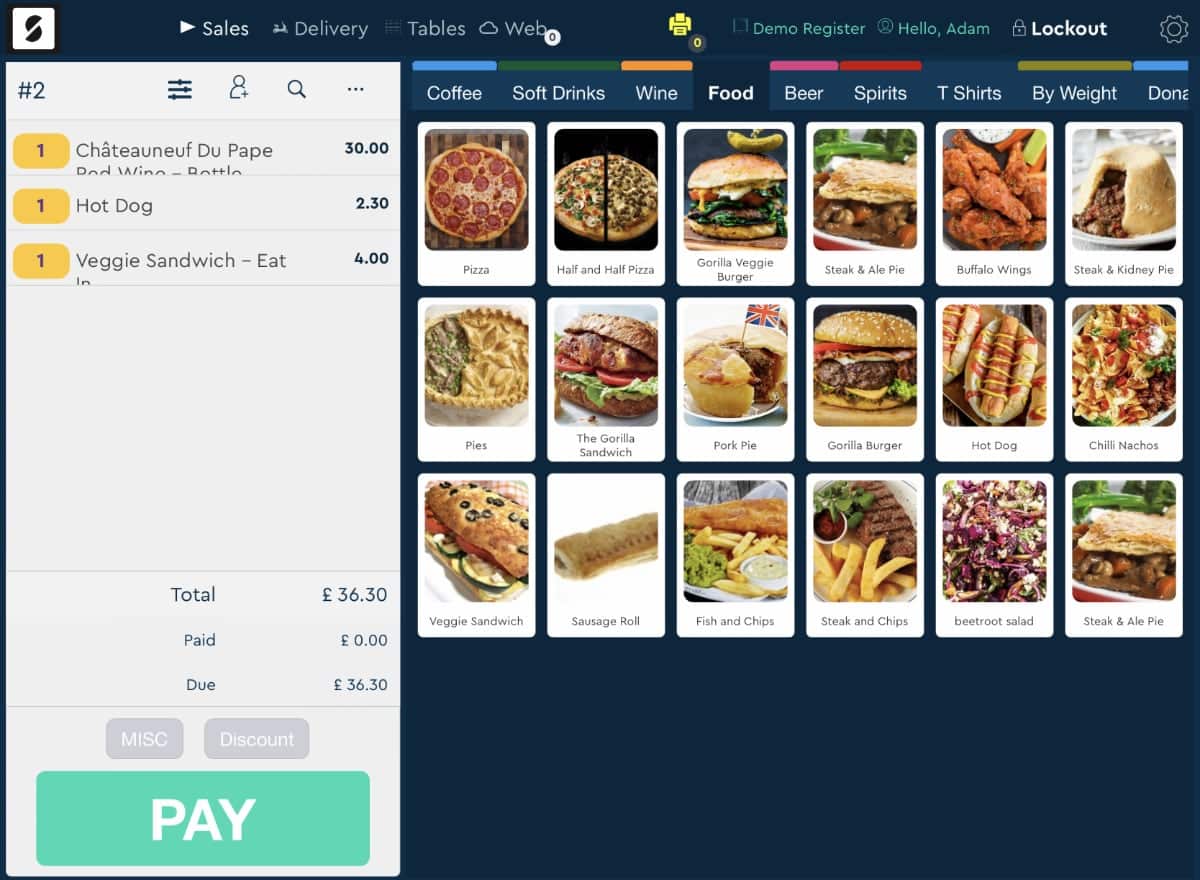
The SumUp POS product menus can be visually tailored with images, varying icon sizes, etc.
£ or % discounts, allergens, customer details and whether the order is for eat-in or takeaway (if selling food) can be indicated. Orders can be saved, voided, registered as a ‘no sale’, marked as waste or petty cash. If an item is not already in the library, it is easily added at checkout with a custom description and VAT.
An ‘Options’ side menu lets you click in or out, close the register, access saved sales and previous transactions. You can refund from here either through scanning the barcode of the receipt or searching through past sales and select the item to refund.
Image: MobileTransaction
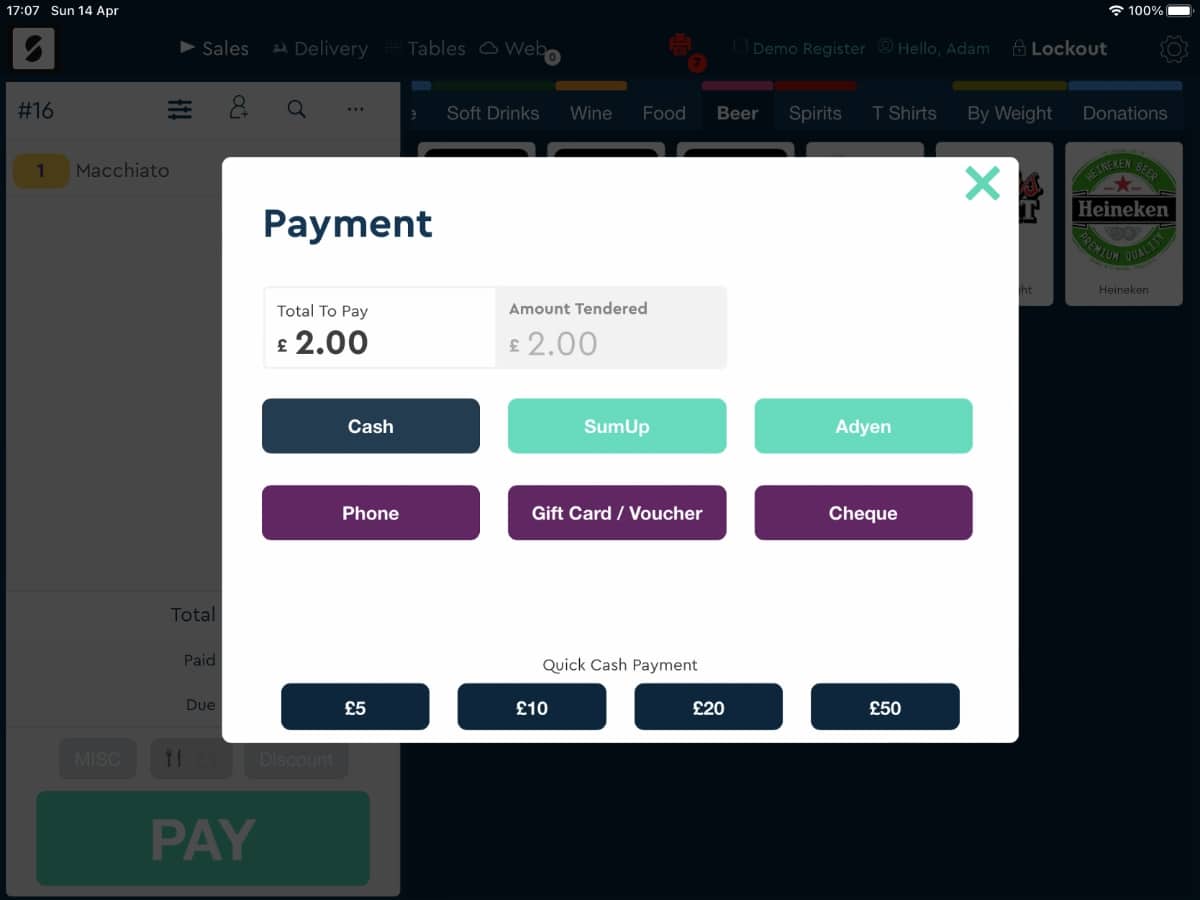
Payment methods in the SumUp POS app.
Payment process: You can accept and track cash, cards, orders on account, gift cards, vouchers or other means.
It gives you an option to accept payment over the phone, but you’ll need to handle this through your chosen payment processor because the till app only gives you the option to register it as ‘Phone’. The same applies to tapping ‘Other’, ‘Gift Card / Voucher’, ‘Account’ on the payment screen – there is no screen for entering a reference number, so you’ll need a system for tracking these yourself.
With an integrated card machine, the POS app will work in conjunction with it for a smooth checkout. If integrated with SumUp payments, the POS app connects with a SumUp card reader and allows you to send payment links or generate a QR code for the transaction directly on the screen.
Receipts: The till app lets you send an email receipt after each sale or print a sales receipt through a connected printer. We’ve seen reports from users that the app automatically prints a receipt every time, even when you tap that it’s not needed, so you can’t actually save on receipt paper until this bug is fixed.
Image: MobileTransaction
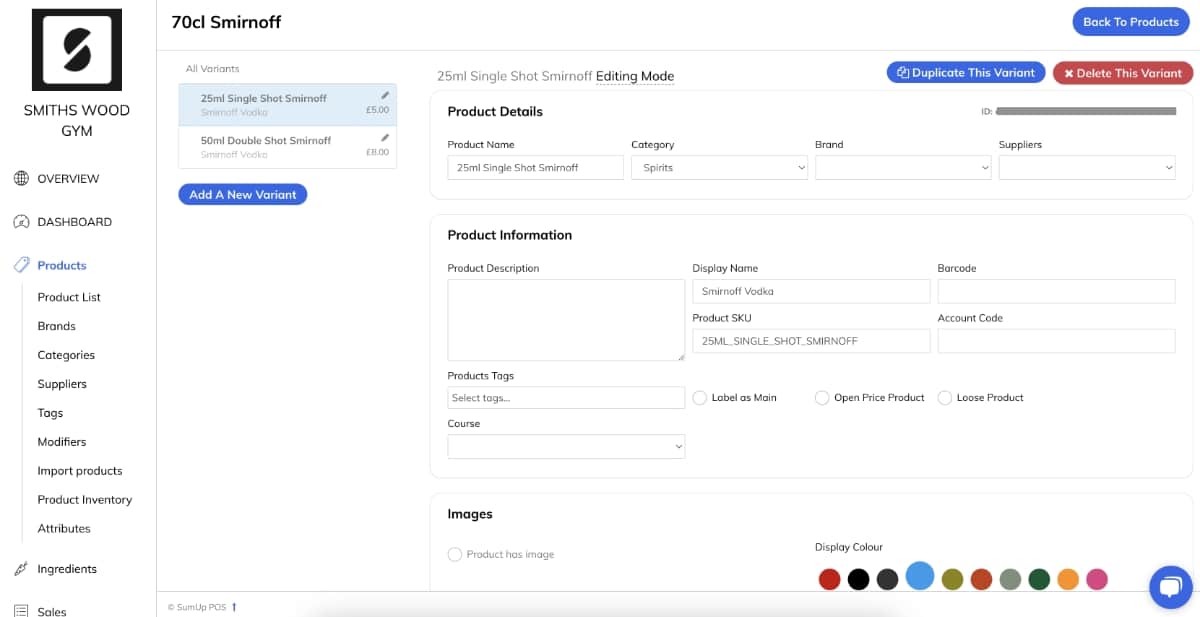
The product settings are fairly extensive in the SumUp POS Dashboard.
Inventory library: Basic product management capabilities is included, such as stock levels, low-stock notifications, supplier lists, bulk product import and a detailed items library.
Each product can be attached to a category and have variants, attributes (added layer of variants), modifiers, tags, SKUs, VAT rates, an image and more. After products are added to your account, it’s time to add them to the till interface through the drag-and-drop ‘Selling Layouts’ in the dashboard.
Image: MobileTransaction
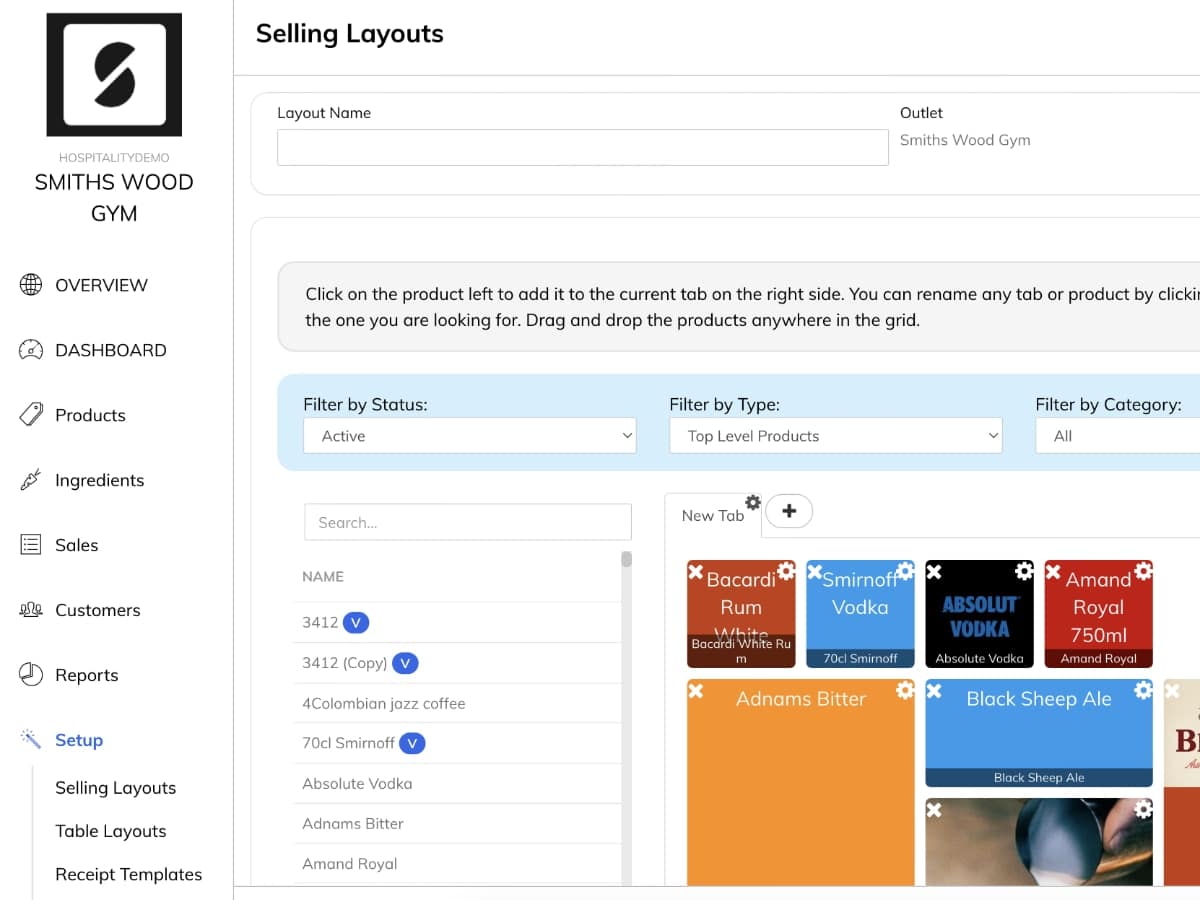
Editing the frontend till layout in Dashboard is relatively easy.
If you subscribe to Advanced Stock, you get more advanced features like:
- Multi-site support
- Integrated and automated purchase orders
- Delivery scheduling
- Stock variance reports
- Wastage reporting
- Stock auditing
Customers and loyalty: The core system allows you to add customers with contact details to a list, divisible into customer groups. If you already have a spreadsheet of people, this can be uploaded to the system to save time.
SumUp recently added points-based loyalty programmes to the core features, which works in conjunction with the customer directory.
Hospitality: Food-and-drink features are automatically included too. To name a few, this covers ingredient-tracking, course and menu management with recipes, table plans with timers, customer tabs, split bills and kitchen printer connections.
Image: MobileTransaction
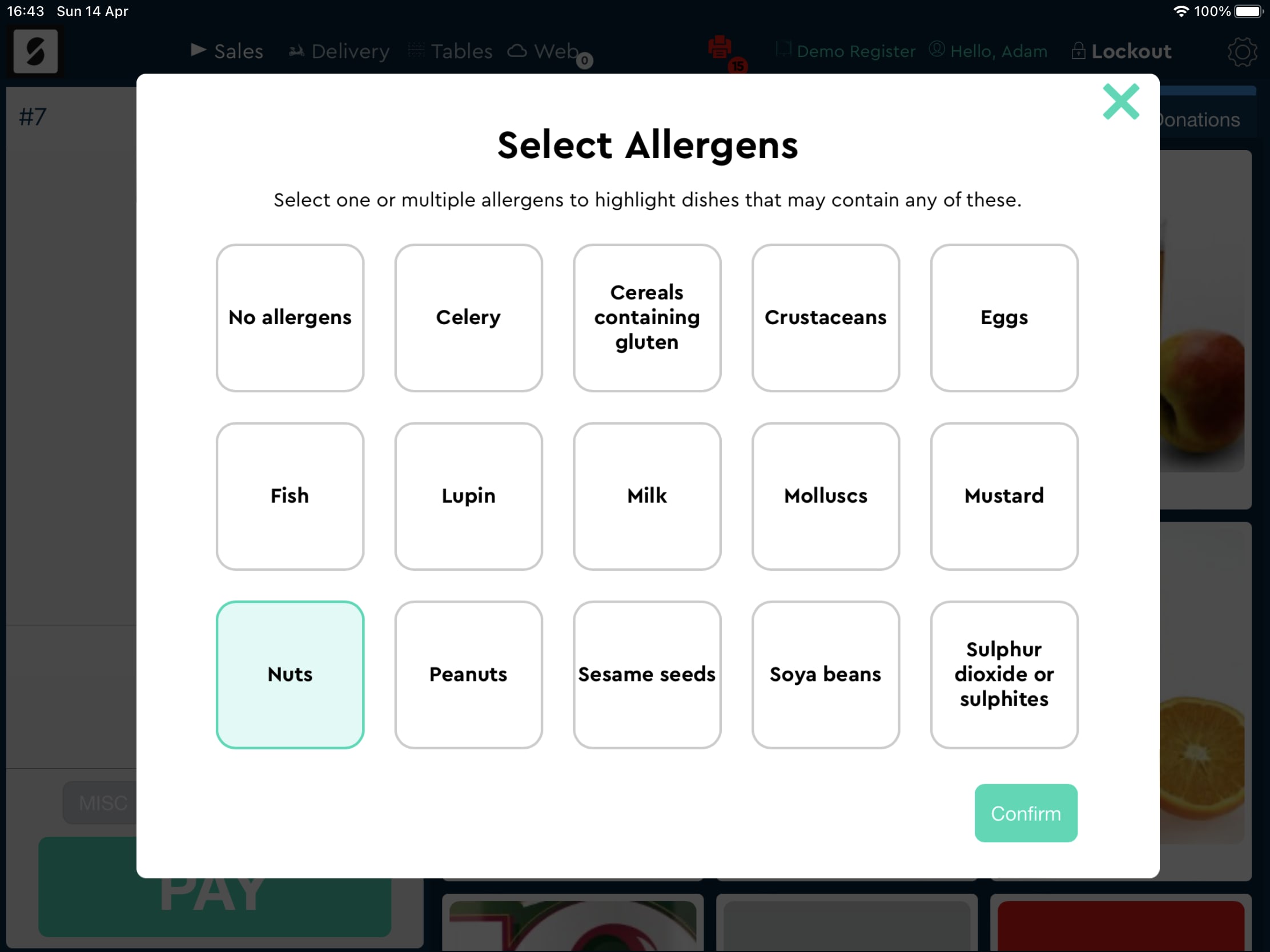
If an allergen is selected, the food menu will show an exclamation mark for dishes containing it.
Employee management: Add employees to the system with custom permissions, a passcode (for till logins) and an image. When users then log in and out of the till, you can track these work hours through the back office. It’s also possible to add more than one admin with access to all settings, and import staff from a spreadsheet.
Offline mode: Not all iPad POS systems work offline, but SumUp Point of Sale does. This makes the app very reliable, although card payments and certain features do require an online connection.
Even when online, you have to refresh the app manually to view changes submitted in the backend Dashboard. This is not very intuitive for frontend staff who have no idea when their manager has made changes in the backend.
Image: MobileTransaction
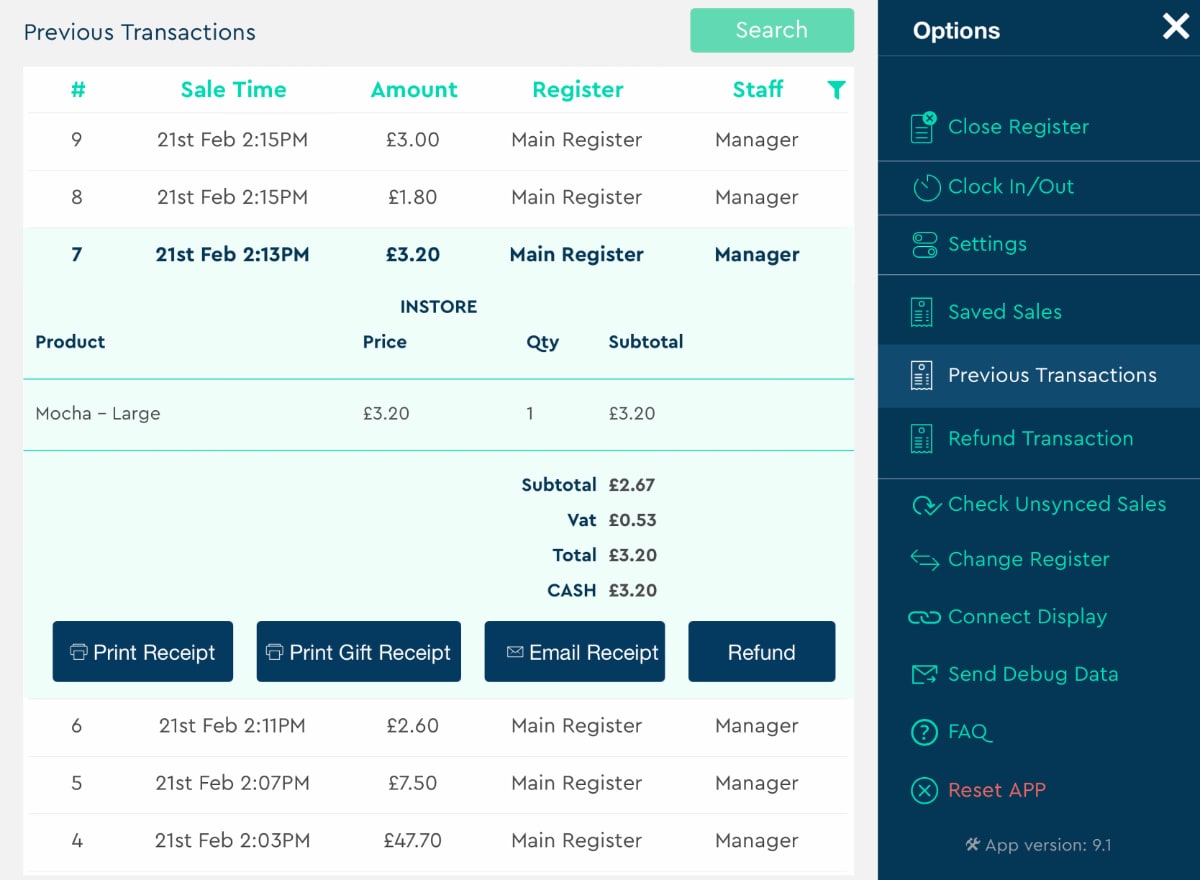
View transactions and refund items through the app’s ‘Options’ side menu.
Reporting: The core reports used to only cover basics like sales monitoring and transaction searches, but SumUp POS has in the last few years added a plethora of extra analytics like:
- Promo reports
- Gross profit reports
- Tips history
The POS app also monitors the cash flow so you can cash up at the end of the day. When closing the register, there’s a complete summary of all the day’s main details around cash, sales categories, payment methods and till movements.
We noticed the daily sales so far (X report) have to be printed, though – they cannot just be viewed on the app screen. This is a peculiarity since not everyone wants to use a printer just for a quick glance.
Card machines and till equipment
Since SumUp owns the POS software, you’ll be encouraged to purchase a SumUp card machine to use in conjunction with the app. There is usually a bundle on offer with an iPad, tablet holder, receipt printer, cash drawer and SumUp Solo terminal, but this will be presented during the sales call.
A big advantage for SumUp Point of Sale users is the low fixed rate they get: usually between 0.99%-1.25% depending on the business sales volume and package. This is a lot lower than Lightspeed’s and Epos Now’s own payment processing fees.
But choosing SumUp for card processing has another major plus: next-day payouts in the SumUp Business Account, including weekends.
Alternatively, you can connect the EPOS with card machines from:
Dojo requires a contract and multiple variable costs, whereas Zettle has a fixed transaction rate of 1.75% and no lock-in.
SumUp POS used to also integrate with Barclaycard, Paymentsense, Retail Merchant Services, Square and Worldpay, but has confirmed with us that only Zettle and Dojo integrate now.
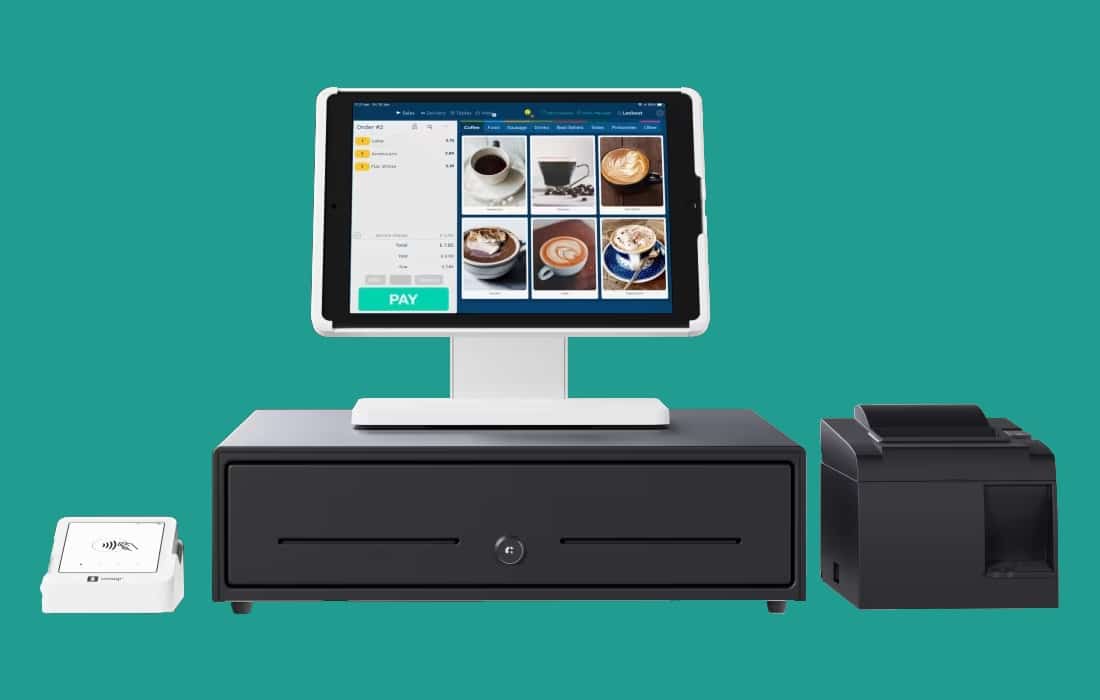
Example of a SumUp Point of Sale hardware bundle.
The system works with different hardware setups to suit your business, including barcode scanners and kitchen printers. The only downside is lack of Android or PC/Mac support for the POS interface. You have to use iPad for the till app. Then again, many cloud-based POS systems rely on iPad nowadays.
Online ordering included
All users get free ‘Goodeats’ (slowly rebranding to ‘SumUp Ordering’) features to accept orders online. This is basically an online web page through which you can accept click-and-collect, delivery or drop-offs remotely.
Online transactions through Goodeats are processed by Stripe, so you’ll need to sign up and connect with Stripe. You decide on a URL, style choices, ordering options and other details displayed on the ordering web page. The URL can then be shared online via social media, Google Business Profile, your website or elsewhere for promotion.
Image: MobileTransaction
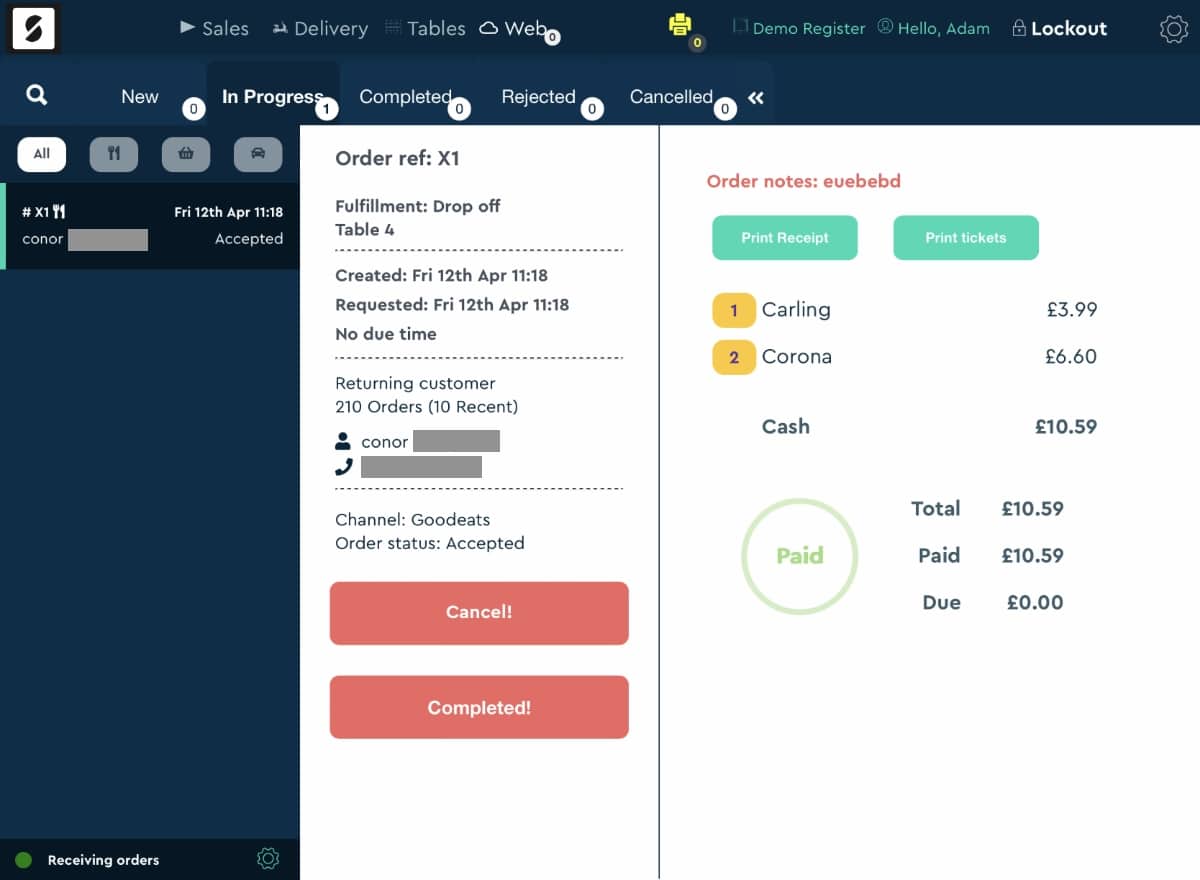
Example of a customer order to drop off at a table.
QR codes can be printed and displayed on your tables or in your windows, allowing customers to place orders without staff interaction. The system also integrates with the Uber Eats, Deliveroo and Stuart takeaway and delivery services.
Want a self-service station? Quick-service businesses can order a large touchscreen SumUp Kiosk to set up for customers to order away from the counter. This is a bit expensive, but worth it for takeaway restaurants, for example.
Integrations
In contrast with SumUp App’s closed-loop, basic software, SumUp Point of Sale connects with a range of external software platforms for additional functions.
If SumUp Ordering is not enough to sell online, Shopify and WooCommerce ecommerce platforms sync with the system.
QuickBooks, Xero, FreeAgent and Pebble also sync with SumUp so you don’t have to export sales data to manually feed into your chosen accounting program.
Restaurants would benefit from the integrations with Kitchen CUT, ResDiary, Fourth and MarketMan.
Other integrations include MailChimp for email marketing and Yoyo for customer loyalty tools. Employee tools can be expanded through Tanda or Planday.
If this does not cover everything for you, you can use APIs and webhooks for your own software arrangement.
Customer service, reviews and experiences
SumUp’s customer support for Point of Sale users is available every day of the week by email and telephone: Monday-Thursday between 8am-7pm, Fridays between 8am-9pm, Saturdays between 10am-9pm, and Sundays and Bank Holidays between 10am-6pm.
The extended hours on Fridays and Saturdays are useful for the social hours of bars, pubs and restaurants, but 9pm isn’t late for these places either. The lack of personal support for emergencies past 9pm could therefore be an issue.
Since Goodtill’s rebrand to SumUp Point of Sale, we’ve noticed an increase of negative reviews from customers. There seems to be a lack of communication from SumUp, slow onboarding causing issues for new businesses, and problems unsubscribing.
Our own experience has not been that easy either, considering a lack of step-by-step guides about specific settings. The resource section is clearly still being built, but if you leave a comment in the Dashboard chat, a support person may actually write a section on your query if it’s not already there (that’s what happened to us within a day of asking about product attributes).
“I’ve sometimes been a bit frustrated with SumUp POS, since I never got prompt replies to queries when testing it in 2024. No one responded to questions on the Goodtill website chat after trying several days, and other contact methods were slow or lacking too. During previous testing in 2022, customer support was more responsive.”
– Emily Sorensen, Senior Editor, MobileTransaction
Furthermore, the Goodtill website – that still exists – contains conflicting information about the features compared to when you test the software yourself. It’s frankly confusing when you compare the resource section with the website, and SumUp’s main website does not help much either.
While testing the app, we also noticed several bugs and shortcomings. If you do too, there’s a feature request section in Dashboard, but SumUp only allocates resources to fixing the highest-rated requests. Even then, some bugs take months to address.

